The buck-boost battery charger IC market is expected to expand from USD 1.2 billion in 2025 to USD 3.1 billion by 2035, supported by the rising need for fast, power-efficient charging across smartphones, tablets, wearables, power tools, and automotive electronics. The first phase of growth through 2030 adds USD 0.56 billion, driven by manufacturers shifting from basic charging circuits to bypass-enabled charger ICs that allow a device to operate while charging, reduce heat buildup, and improve charging speed. By the second half of the period, the market adds another USD 1.38 billion, as intelligent charging algorithms and tighter integration with battery management systems become standard features.
Consumer electronics remain the largest application segment, accounting for more than half of global demand, primarily due to fast-charging smartphone ecosystems and USB Power Delivery adoption. Meanwhile, power tools and electric mobility applications gain momentum as battery capacities increase and charging performance becomes a differentiator. Asia Pacific leads manufacturing and volume scaling, while Europe and North America drive high-performance, safety-critical applications. Key suppliers such as Texas Instruments, Analog Devices, Renesas, and SG Micro are increasingly focusing on efficiency, thermal performance, and compatibility with next-generation battery chemistries.
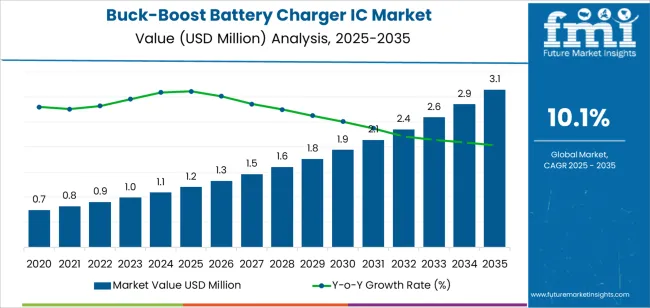
Buck-Boost Battery Charger IC Market Year-over-Year Forecast (2025-2035)
The latter half (2030-2035) will witness sustained growth from USD 1.77 billion to USD 3.1 billion, representing an addition of USD 1.38 billion or 71% of the decade's expansion. This period will be defined by mass market penetration of intelligent charging algorithms, integration with battery management platforms, and seamless compatibility with existing power electronics infrastructure. The market trajectory signals fundamental shifts in how manufacturers approach charging efficiency optimization and power conversion management, with participants positioned to benefit from sustained demand across multiple function types and electronics application segments.
The Buck-Boost Battery Charger IC market demonstrates distinct growth phases with varying market characteristics and competitive dynamics. Between 2025 and 2030, the market progresses through its technology adoption phase, expanding from USD 1.2 billion to USD 1.77 billion with steady annual increments averaging 10.1% growth. This period showcases the transition from basic charging circuits to advanced bypass-enabled systems with enhanced efficiency capabilities and integrated protection systems becoming mainstream features.
The 2025-2030 phase adds USD 0.56 billion to market value, representing 29% of total decade expansion. Market maturation factors include standardization of USB Power Delivery protocols, declining component costs for specialized charging ICs, and increasing industry awareness of fast charging benefits reaching 95-98% conversion efficiency in smartphone and portable electronics applications. Competitive landscape evolution during this period features established semiconductor manufacturers like Texas Instruments and Analog Devices expanding their charging IC portfolios while specialized power management companies focus on advanced algorithm development and enhanced thermal performance capabilities.
From 2030 to 2035, market dynamics shift toward intelligent charging integration and global electronics expansion, with growth continuing from USD 1.77 billion to USD 3.1 billion, adding USD 1.38 billion or 71% of total expansion. This phase transition centers on AI-enabled charging systems, integration with wireless power networks, and deployment across diverse consumer electronics and automotive scenarios, becoming standard rather than specialized applications. The competitive environment matures with focus shifting from basic charging capability to comprehensive power optimization systems and integration with battery health monitoring platforms.
At-a-Glance Metrics
| Metric | Value |
|---|---|
| Market Value (2025) | USD 1.2 billion |
| Market Forecast (2035) | USD 3.1 billion |
| Growth Rate | 10.1% CAGR |
| Leading Technology | With Bypass Charging Function |
| Primary Application | Consumer Electronics |
The market demonstrates strong fundamentals with bypass charging function systems capturing a dominant share through advanced power path management and charging speed optimization capabilities. Consumer electronics applications drive primary demand, supported by increasing smartphone production and fast charging technology requirements. Geographic expansion remains concentrated in developed markets with established electronics manufacturing infrastructure, while emerging economies show accelerating adoption rates driven by portable device proliferation and rising power efficiency standards.
Market expansion rests on three fundamental shifts driving adoption across consumer electronics, power tools, and automotive electronics sectors. First, fast charging demand creates compelling operational advantages through buck-boost charger ICs that provide immediate charging speed improvement and battery longevity enhancement without compromising device safety standards, enabling manufacturers to meet consumer expectations while maintaining thermal management and reducing charging time significantly. Second, portable device modernization accelerates as electronics brands worldwide seek advanced charging systems that complement battery technologies, enabling precise voltage regulation and current control that align with USB Power Delivery standards and device requirements.
Third, battery efficiency optimization drives adoption from smartphone manufacturers and power tool producers requiring effective charging solutions that maximize battery performance while maintaining operational safety during charging and discharging operations. However, growth faces headwinds from design complexity challenges that vary across IC suppliers regarding thermal management and component integration requirements, which may limit adoption in cost-sensitive electronics applications. Technical limitations also persist regarding electromagnetic interference and layout sensitivity concerns that may reduce effectiveness in compact device designs, which affect charging performance and system reliability.
The buck-boost battery charger IC market represents a specialized yet critical power management opportunity driven by expanding global portable electronics production, fast charging technology modernization, and the need for superior power conversion efficiency in diverse battery applications. As manufacturers worldwide seek to achieve charging speed enhancement, extend battery lifespan, and integrate advanced charging ICs with battery management systems, buck-boost chargers are evolving from basic voltage regulators to sophisticated power management solutions ensuring charging excellence and device competitiveness.
The market's growth trajectory from USD 1.2 billion in 2025 to USD 3.1 billion by 2035 at a 10.1% CAGR reflects fundamental shifts in electronics industry charging requirements and power management optimization. Geographic expansion opportunities are particularly pronounced in Asia Pacific markets, while the dominance of bypass charging function systems and consumer electronics applications provides clear strategic focus areas.
Strengthening the dominant bypass charging function segment through enhanced power path management, superior thermal efficiency, and rapid charging capabilities. This pathway focuses on optimizing charging algorithms, improving conversion efficiency, extending operational effectiveness to wide input voltage ranges, and developing specialized configurations for demanding applications. Market leadership consolidation through advanced power management engineering and intelligent control integration enables premium positioning while defending competitive advantages against basic charging systems. Expected revenue pool: USD 320-380 million
Rapid consumer electronics and portable device growth across Asia Pacific creates substantial expansion opportunities through local semiconductor production and technology transfer partnerships. Growing smartphone manufacturing and government electronics industry initiatives drive sustained demand for advanced charger IC systems. Localization strategies reduce procurement costs, enable faster design support, and position companies advantageously for electronics programs while accessing growing domestic markets. Expected revenue pool: USD 280-340 million
Expansion within the dominant consumer electronics segment through specialized IC designs addressing smartphone charging standards and high-power device requirements. This pathway encompasses USB-C integration systems, wireless charging compatibility, and multi-device charging support for diverse electronics manufacturing processes. Premium positioning reflects superior charging performance and comprehensive safety compliance supporting modern consumer device production. Expected revenue pool: USD 260-320 million
Strategic expansion into power tool applications requires enhanced current handling and specialized IC configurations addressing cordless tool operational requirements. This pathway addresses high-power battery charging, rapid charge cycle support, and ruggedized packaging with advanced thermal engineering for demanding industrial standards. Premium pricing reflects specialized performance requirements and extended operational life standards. Expected revenue pool: USD 220-280 million
Development of specialized charger IC configurations for automotive electronics applications and other segments, addressing specific battery management requirements and safety-critical demands. This pathway encompasses automotive-grade reliability, extended temperature operation, and diagnostic capabilities for emerging electrification segments. Technology differentiation through automotive qualification enables diversified revenue streams while reducing dependency on consumer electronics platforms. Expected revenue pool: USD 180-240 million
Expansion of non-bypass charging segment through enhanced cost efficiency, simplified integration, and standard charging applications. This pathway encompasses budget electronics devices, basic charging requirements, and high-volume production scenarios requiring economical charging solutions. Market development through value engineering enables differentiated positioning while accessing cost-sensitive markets requiring reliable charging functionality. Expected revenue pool: USD 150-200 million
Development of advanced charging intelligence addressing battery longevity optimization and adaptive charging requirements across consumer electronics and automotive applications. This pathway encompasses machine learning integration, battery impedance tracking, and comprehensive health monitoring functionality. Premium positioning reflects technology leadership and battery science expertise while enabling access to premium device programs and battery technology partnerships. Expected revenue pool: USD 120-170 million
Primary Classification: The market segments by function type into With Bypass Charging Function and Without Bypass Charging Function categories, representing the evolution from basic charging circuits to advanced power path management solutions for comprehensive battery charging optimization.
Secondary Classification: Application segmentation divides the market into Consumer Electronics, Power Tools, Automotive Electronics, and Others sectors, reflecting distinct requirements for charging speed, power capacity, and safety management standards.
Regional Classification: Geographic distribution covers Asia Pacific, Europe, North America, and other regions, with developed markets leading adoption while emerging economies show accelerating growth patterns driven by electronics manufacturing expansion programs.
The segmentation structure reveals technology progression from standard charging systems toward bypass-enabled solutions with enhanced power management and intelligent control capabilities, while application diversity spans from smartphone charging to specialized automotive battery management requiring precise charging IC solutions.
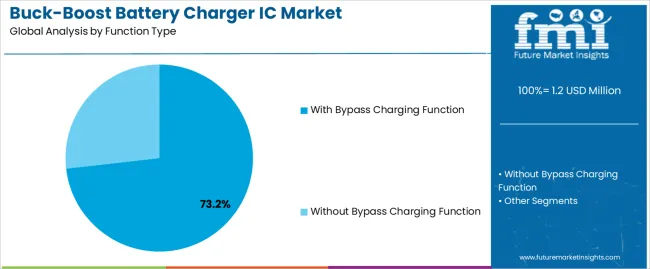
Market Position: Bypass charging function systems command the leading position in the Buck-Boost Battery Charger IC market with approximately 73.2% market share through advanced power path features, including direct battery operation capability, uninterrupted device functionality, and thermal optimization that enable manufacturers to achieve optimal charging performance across diverse portable electronics and automotive environments.
Value Drivers: The segment benefits from device manufacturer preference for continuous operation systems that provide simultaneous charging and usage capability, reduced heat generation, and user experience enhancement without requiring charging interruption. Advanced bypass features enable power-through operation, faster charging completion, and compatibility with high-performance devices, where operational continuity and thermal management represent critical performance requirements.
Competitive Advantages: Bypass charging function systems differentiate through proven efficiency standards, consistent thermal performance, and integration with advanced battery management systems that enhance operational effectiveness while maintaining optimal charging safety suitable for diverse consumer electronics applications.
Key market characteristics:
Non-bypass charging function systems maintain strategic positioning in the Buck-Boost Battery Charger IC market due to their simplified design architecture and cost optimization advantages. These systems appeal to manufacturers requiring basic charging functionality, standard power conversion, and economical solutions for budget electronics applications. Market adoption is driven by cost-sensitive device emphasis, featuring reliable charging performance and simplified thermal management through optimized non-bypass IC systems while maintaining adequate charging capability.
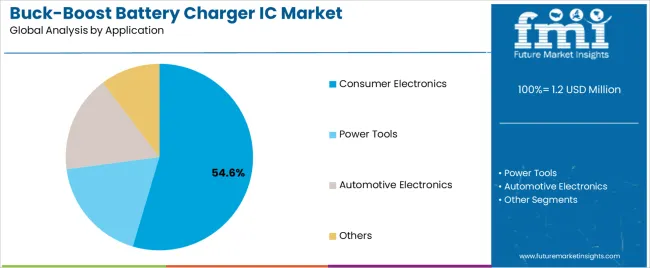
Market Context: Consumer electronics applications dominate the Buck-Boost Battery Charger IC market with approximately 54.6% market share due to widespread adoption of fast charging technology and increasing focus on battery performance, device portability, and user experience applications that minimize charging time while maintaining smartphone and tablet industry standards.
Appeal Factors: Consumer electronics manufacturers prioritize charging speed, thermal efficiency, and integration with existing battery technologies that enables coordinated IC deployment across multiple device models. The segment benefits from substantial smartphone production investment and fast charging programs that emphasize the acquisition of advanced charger ICs for competitive differentiation and user satisfaction applications.
Growth Drivers: Smartphone modernization programs incorporate buck-boost charger ICs as standard power management for mobile device operations, while wearable electronics growth increases demand for miniaturized charging capabilities that comply with space constraints and minimize power consumption.
Market Challenges: Varying device battery configurations and fast charging protocol differences may limit IC standardization across different device platforms or operational scenarios.
Application dynamics include:
Power tool applications capture approximately 23.1% market share through specialized charging requirements in cordless drill manufacturing, battery-powered equipment production, and professional tool applications. These manufacturers demand robust charger IC systems capable of managing high-current charging while providing rapid charge cycle and battery protection capabilities.
Automotive electronics applications account for approximately 14.5%, while other segments capture 7.8%, including industrial equipment charging, medical device power management, and specialized battery applications requiring charger IC capabilities for reliable power conversion and battery longevity.
Growth Accelerators: Portable electronics expansion drives primary adoption as buck-boost charger ICs provide superior fast charging capabilities that enable device manufacturers to meet consumer expectations without excessive charging time, supporting product differentiation missions that require precise power management applications. Battery technology advancement demand accelerates market expansion as electronics brands seek effective charging systems that maximize battery lifespan while maintaining operational safety during rapid charging and high-power transfer scenarios. Semiconductor innovation spending increases worldwide, creating sustained demand for intelligent charging IC systems that complement advanced battery chemistries and provide thermal management improvement in competitive consumer markets.
Growth Inhibitors: Design integration cost challenges vary across IC suppliers regarding thermal management complexity and layout optimization requirements, which may limit operational flexibility and market penetration in regions with budget constraints or cost-sensitive electronics manufacturing. Technical performance limitations persist regarding electromagnetic compatibility and component placement sensitivity that may reduce effectiveness in compact device layouts, high-density circuit boards, or wireless charging conditions, affecting charging reliability and system performance. Market fragmentation across multiple charging protocol standards and battery management platforms creates compatibility concerns between different IC manufacturers and existing device infrastructure.
Market evolution patterns show adoption accelerating in premium smartphone and flagship device sectors where fast charging justifies IC investment costs, with geographic concentration in developed markets transitioning toward mainstream adoption in emerging economies driven by portable device proliferation and consumer technology awareness. Technology development focuses on gallium nitride integration, artificial intelligence algorithms, and compatibility with wireless power standards that optimize charging speed and battery health effectiveness. The market could face disruption if alternative charging technologies or solid-state battery innovations significantly limit the deployment of conventional charger ICs in electronics applications, though buck-boost converters' unique combination of voltage flexibility, efficiency optimization, and universal compatibility continues to make them preferred in battery-powered devices.
The Buck-Boost Battery Charger IC market demonstrates varied regional dynamics with Growth Leaders including China (13.6% CAGR) and India (12.6% CAGR) driving expansion through electronics manufacturing capacity additions and smartphone production programs. Steady Performers encompass Germany (11.6% CAGR), Brazil (10.6% CAGR), and United States (9.6% CAGR), benefiting from established semiconductor industries and advanced power electronics adoption. Mature Markets feature United Kingdom (8.6% CAGR) and Japan (7.6% CAGR), where specialized consumer electronics applications and automotive integration support consistent growth patterns.

| Country | CAGR (2025-2035) |
|---|---|
| China | 13.6% |
| India | 12.6% |
| Germany | 11.6% |
| Brazil | 10.6% |
| United States | 9.6% |
| United Kingdom | 8.6% |
| Japan | 7.6% |
Regional synthesis reveals Asia Pacific markets leading adoption through electronics manufacturing expansion and smartphone production infrastructure development, while European countries maintain steady expansion supported by automotive electronics advancement and power management standardization requirements. North American markets show moderate growth driven by consumer device applications and semiconductor innovation integration trends.
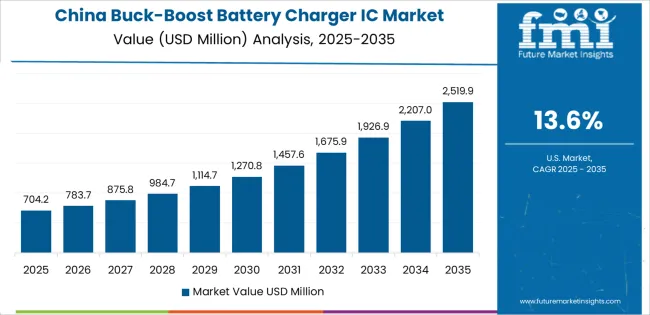
The Chinese market emphasizes advanced IC features, including intelligent charging algorithms and comprehensive battery management integration that coordinate power delivery, thermal monitoring, and safety protection applications through unified semiconductor systems. The country demonstrates strong growth at 13.6% CAGR, driven by smartphone manufacturing expansion, consumer electronics production, and emerging semiconductor industry development that support charger IC integration. Chinese electronics manufacturers prioritize operational effectiveness with charging ICs delivering consistent performance through advanced protocol support and thermal management features.
Technology deployment channels include major smartphone manufacturers, power tool producers, and electric vehicle companies that support professional applications for complex battery charging and high-volume production applications. IC integration capabilities with domestic battery management systems expand market appeal across diverse operational requirements seeking fast charging and cost optimization benefits. The expanding electronics sector and accelerating fast charging adoption create sustained demand, while innovative applications in wireless charging and USB-C power delivery open new growth avenues.
Performance Metrics:
Germany's advanced semiconductor market demonstrates sophisticated IC deployment with documented operational effectiveness in automotive electronics applications and industrial device facilities through integration with existing power management systems and vehicle infrastructure. The country leverages engineering expertise in power conversion technology and automotive systems integration to maintain strong growth at 11.6% CAGR. Industrial centers, including Munich, Stuttgart, and Dresden, showcase advanced installations where charger IC systems integrate with comprehensive vehicle electronics platforms and battery management networks to optimize charging operations and power effectiveness.
German manufacturers prioritize system reliability and automotive qualification in IC development, creating demand for certified systems with advanced features, including functional safety compliance and extended temperature operation. The market benefits from established automotive infrastructure and willingness to invest in power electronics technologies that provide long-term vehicle performance benefits and compliance with international automotive and safety standards.
Market Intelligence Brief:
The USA buck-boost charger IC market demonstrates sophisticated deployment across consumer electronics applications with documented effectiveness in smartphone manufacturing and portable device production through integration with comprehensive power management systems and battery technology infrastructure. The country leverages advanced semiconductor capabilities in IC design and power electronics innovation to maintain moderate growth at 9.6% CAGR. Technology centers, including Silicon Valley, Austin, and Boston, showcase advanced installations where charger IC systems integrate with comprehensive device platforms and charging standard networks to optimize power delivery and charging effectiveness.
American semiconductor companies prioritize innovation and performance optimization in IC development, creating demand for advanced systems with cutting-edge features, including gallium nitride technology and artificial intelligence integration. The market benefits from established technology infrastructure and willingness to invest in semiconductor technologies that provide long-term device competitiveness benefits and compliance with consumer electronics standards.
Market Intelligence Brief:
The UK buck-boost charger IC market demonstrates steady semiconductor adoption with documented operational effectiveness in consumer electronics applications and portable device manufacturing through integration with existing power management systems and charging infrastructure. The country leverages technology expertise in semiconductor design and power electronics engineering to maintain steady growth at 8.6% CAGR. Technology centers, including Cambridge, London, and Manchester, showcase electronics installations where charger IC systems integrate with comprehensive device platforms and battery management networks to optimize charging efficiency and power effectiveness.
British electronics manufacturers prioritize system efficiency and charging performance in IC development, creating demand for optimized systems with advanced features, including adaptive charging control and thermal protection integration. The market benefits from established technology infrastructure and commitment to invest in power electronics solutions that provide long-term device performance benefits and compliance with UK electronics standards. Consumer device applications, wearable electronics, and IoT device charging drive diversified demand across multiple technology segments.
Strategic Market Indicators:
India's buck-boost charger IC market demonstrates rapid expansion with documented operational effectiveness in smartphone manufacturing applications and consumer electronics production through integration with emerging semiconductor systems and electronics manufacturing infrastructure. The country leverages growing technology capabilities in electronics production and semiconductor adoption to achieve high growth at 12.6% CAGR. Manufacturing centers, including Bangalore, Mumbai, and Delhi, showcase expanding installations where charger IC systems integrate with comprehensive device platforms and battery management networks to optimize production efficiency and charging effectiveness.
Indian electronics manufacturers prioritize cost optimization and charging performance in IC development, creating demand for economical systems with essential features, including fast charging support and standard protocol compatibility. The market benefits from expanding smartphone production infrastructure and willingness to invest in power management solutions that provide competitive device features and compliance with international charging standards.
Market Intelligence Brief:
Brazil's buck-boost charger IC market demonstrates steady expansion with documented operational effectiveness in consumer electronics applications and portable device manufacturing through integration with power management systems and charging infrastructure. The country leverages developing electronics capabilities in semiconductor adoption and device production to maintain moderate growth at 10.6% CAGR. Manufacturing centers, including São Paulo, Campinas, and Manaus, showcase growing installations where charger IC systems integrate with comprehensive device platforms and battery networks to optimize charging operations and power management.
Brazilian electronics manufacturers prioritize charging reliability and cost effectiveness in IC development, creating demand for robust systems with essential features, including standard charging protocols and thermal protection. The market benefits from expanding consumer electronics sector and commitment to invest in power management technologies that provide device performance improvements and charging capability benefits.
Strategic Market Indicators:
Japan's buck-boost charger IC market demonstrates precision deployment with documented operational effectiveness in advanced consumer electronics applications and automotive power systems through integration with sophisticated battery management systems and vehicle infrastructure. The country leverages engineering excellence in power electronics integration and semiconductor precision to maintain steady growth at 7.6% CAGR. Technology centers, including Tokyo, Osaka, and Nagoya, showcase advanced installations where charger IC systems integrate with comprehensive quality management platforms and vehicle electronics networks to optimize charging excellence and power effectiveness.
Japanese semiconductor manufacturers prioritize system precision and reliability in IC development, creating demand for high-performance systems with advanced features, including ultra-precise current control and intelligent thermal management. The market benefits from established automotive electronics infrastructure and commitment to invest in highest-quality power management technologies that provide superior operational performance and compliance with stringent Japanese quality standards.
Strategic Market Indicators:
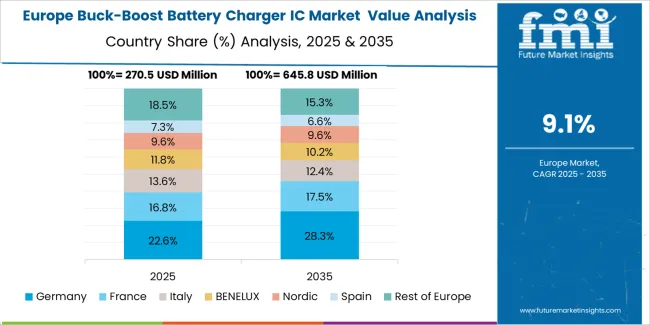
The Buck-Boost Battery Charger IC market in Europe is projected to grow substantially over the forecast period, with Germany expected to maintain its leadership position with a significant market share supported by its advanced automotive electronics infrastructure and major semiconductor centers in Munich and Dresden. France follows with strong market presence, driven by comprehensive consumer electronics programs and power tool manufacturing initiatives. The United Kingdom holds substantial market share through specialized semiconductor design activities, portable device applications, and electronics production facilities. Italy commands notable market presence through strong consumer appliance manufacturing and automotive electronics projects. Spain accounts for growing market share aided by electronics production expansion and power management adoption. The Netherlands maintains steady share driven by technology innovation and semiconductor industry demand. The Rest of Europe region is anticipated to show steady adoption, reflecting consistent growth in Nordic countries, electronics expansion in Central European markets, and manufacturing modernization upgrades across Eastern European semiconductor facilities.

In Japan, the Buck-Boost Battery Charger IC market prioritizes bypass charging function systems, which capture the dominant share of premium smartphone and automotive electronics installations due to their advanced features, including precision thermal management optimization and seamless integration with existing battery management infrastructure. Japanese electronics manufacturers emphasize reliability, efficiency, and long-term operational excellence, creating demand for bypass-enabled systems that provide consistent charging capabilities and superior power management based on device requirements and quality standards. Non-bypass charging ICs maintain secondary positions primarily in budget consumer devices and standard electronics installations where basic charging functionality meets requirements without compromising cost effectiveness.
Market Characteristics:
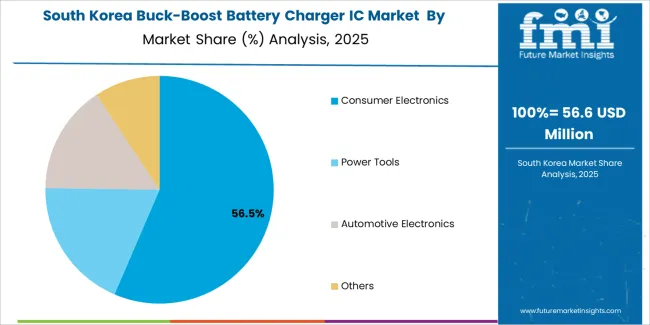
In South Korea, the market structure favors international semiconductor manufacturers, including Texas Instruments, Analog Devices, and Renesas, which maintain dominant positions through comprehensive IC portfolios and established electronics networks supporting both large consumer device implementations and automotive electronics installations. These providers offer integrated solutions combining advanced charger IC systems with professional technical support and ongoing design assistance that appeal to Korean electronics brands seeking reliable power management solutions. Local semiconductor companies and fabless design houses capture moderate market share by providing localized IC capabilities and competitive pricing for standard consumer electronics installations, while domestic manufacturers focus on specialized applications and cost-effective solutions tailored to Korean electronics market characteristics.
Channel Insights:

The Buck-Boost Battery Charger IC market operates with moderate concentration, featuring approximately 12-15 meaningful participants, where leading companies control roughly 60-65% of the global market share through established electronics relationships and comprehensive power management IC portfolios. Competition emphasizes advanced semiconductor capabilities, charging protocol support, and thermal performance excellence rather than price-based rivalry. The leading company, Texas Instruments, commands approximately 29.0% market share through its extensive power management IC product line and global semiconductor presence.
Market Leaders encompass Texas Instruments, Analog Devices, and Renesas, which maintain competitive advantages through extensive power electronics expertise, global semiconductor networks, and comprehensive application engineering capabilities that create customer loyalty and support premium pricing. These companies leverage decades of IC design experience and ongoing technology investments to develop advanced charger IC systems with intelligent control features and safety integration capabilities. Technology Innovators include SG Micro, Southchip, and Injoinic, which compete through specialized charging algorithm technology focus and innovative IC designs that appeal to electronics manufacturers seeking advanced power management solutions and cost optimization.
These companies differentiate through rapid product development cycles and specialized consumer electronics application focus. Regional Specialists feature semiconductor manufacturers focusing on specific geographic markets and specialized applications, including low-power charging systems and automotive-grade solutions. Market dynamics favor participants that combine reliable charging performance with advanced system capabilities, including adaptive charging algorithms and predictive thermal management features. Competitive pressure intensifies as traditional power management suppliers expand into intelligent charging systems, while specialized fabless companies challenge established players through innovative gallium nitride solutions and integrated power platforms targeting consumer electronics and automotive segments.
| Item | Value |
|---|---|
| Quantitative Units | USD 1.2 billion |
| Function Type | With Bypass Charging Function, Without Bypass Charging Function |
| Application | Consumer Electronics, Power Tools, Automotive Electronics, Others |
| Regions Covered | Asia Pacific, Europe, North America, Latin America, Middle East & Africa |
| Countries Covered | China, India, Germany, United States, United Kingdom, Japan, Brazil, and 20+ additional countries |
| Key Companies Profiled | Texas Instruments, Analog Devices, Renesas, SG Micro, Southchip, Injoinic, Powlicon, Si-power, WPINNO |
| Additional Attributes | Dollar sales by function type and application categories, regional adoption trends across Asia Pacific, Europe, and North America, competitive landscape with IC manufacturers and power management suppliers, manufacturer preferences for charging efficiency and thermal performance, integration with battery management platforms and device power systems, innovations in intelligent charging algorithms and gallium nitride technology, and development of fast charging solutions with enhanced performance and power conversion optimization capabilities. |
The global buck-boost battery charger ic market is estimated to be valued at USD 1.2 million in 2025.
The market size for the buck-boost battery charger ic market is projected to reach USD 3.1 million by 2035.
The buck-boost battery charger ic market is expected to grow at a 10.1% CAGR between 2025 and 2035.
The key product types in buck-boost battery charger ic market are with bypass charging function and without bypass charging function.
In terms of application, consumer electronics segment to command 54.6% share in the buck-boost battery charger ic market in 2025.






Full Research Suite comprises of:
Market outlook & trends analysis
Interviews & case studies
Strategic recommendations
Vendor profiles & capabilities analysis
5-year forecasts
8 regions and 60+ country-level data splits
Market segment data splits
12 months of continuous data updates
DELIVERED AS:
PDF EXCEL ONLINE
Battery Operated Light Market Forecast and Outlook 2025 to 2035
Battery Voltage Recorder Market Size and Share Forecast Outlook 2025 to 2035
Battery Resistance Tester Market Size and Share Forecast Outlook 2025 to 2035
Battery Technology Market Size and Share Forecast Outlook 2025 to 2035
Battery Separator Paper Market Size and Share Forecast Outlook 2025 to 2035
Battery Cyclers Market Size and Share Forecast Outlook 2025 to 2035
Battery Voltage Supervisor Market Size and Share Forecast Outlook 2025 to 2035
Battery Platforms Market Analysis Size and Share Forecast Outlook 2025 to 2035
Battery Management System Market Report – Growth & Forecast 2025-2035
Battery Binders Market Size and Share Forecast Outlook 2025 to 2035
Battery Materials Recycling Market Size and Share Forecast Outlook 2025 to 2035
Battery Packaging Material Market Size and Share Forecast Outlook 2025 to 2035
Battery Energy Storage System Industry Analysis by Battery Type, Connection Type, Ownership, Energy Capacity, Storage System, Application, and Region through 2025 to 2035
Battery Materials Market: Growth, Trends, and Future Opportunities
Battery Electrolytes Market Analysis & Forecast by Type, End-Use, and Region through 2035
Battery Testing Equipment Market Growth – Trends & Forecast 2025 to 2035
Battery Swapping Charging Infrastructure Market Trends and Forecast 2025 to 2035
Battery-Free Sensors Market Insights - Trends & Forecast 2025 to 2035
Competitive Breakdown of Battery Management System Providers
Battery Manufacturing Machines Market

Thank you!
You will receive an email from our Business Development Manager. Please be sure to check your SPAM/JUNK folder too.
Chat With
MaRIA